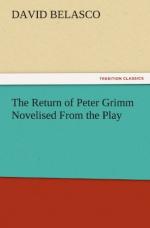“God does not send us strange flowers every year, When the warm winds blow o’er the pleasant places, The same fair flowers lift up the same fair faces. The violet is here ... It all comes back, the odour, grace and hue, ... it IS the THING WE KNEW. So after the death winter it shall be,” etc.
Against a background of budding trees, I placed the action of the play in the month of April; April with its swift transitions from bright sunlight to the darkness of passing clouds and showers. April weather furnished a natural reason for raising and lowering the lights—that the dead could come and go at will, seen or unseen. The passing rain-storms blended with the tears of those weeping for their loved ones. A man who comes back must not have a commonplace name—a name suggestive of comedy—and I think I must have read over every Dutch name that ever came out of Holland before I selected the name of “Peter Grimm.” It was chosen because it suggested (to me) a stubborn old man with a sense of justice—whose spirit would return to right a wrong and adjust his household affairs.
The stage setting was evolved after extreme care and thought. It was a mingling of the past and present. It was Peter’s sitting-room, with a mixture of furniture and family portraits and knick-knacks, each with an association of its own. It was such a room as would be dear to all old-fashioned, home-loving people—unlike a room of the present, from which every memento of parents and grand-parents would be banished in favour of strictly modern or antique formal furniture. In this room, the things of Peter’s father mingled with those of Peter’s boyhood and young manhood. This was done in order that the influence of his familiar belongings might be felt by the people of the play. When his niece stood with her hand on his chair; when she saw the lilies he loved; when she touched his pipe, or any of the familiar objects dear to her because of their associations,_ PETER was brought vividly back to her mind, although she could not see him.
Peter’s clothing was selected with unusual care so that it would not catch the reflection from the lights. Months of preparation and weeks of rehearsal were necessary.
One detail that was especially absorbing was the matter of lighting; catching the high lights and shadows. This was the first time the “bridge of lights” was used on any stage. Lighting has always been to me more than mere illumination. It is a revelation of the heart and soul of the story. It points the way. Lights should be to the play what the musical accompaniment is to the singer. A wordless story could be told by lights. Lights should be mixed as a painter mixes his colours—a bit of pink here, of blue there; a touch of red, a lavender or a deep purple, with shadows intervening to give the desired effect. Instead of throwing a mysterious light upon the figure of Peter, I decided to reverse the process and put no lights on him. The light was on the other people—the people still in life, with just enough amber to give them colour.




